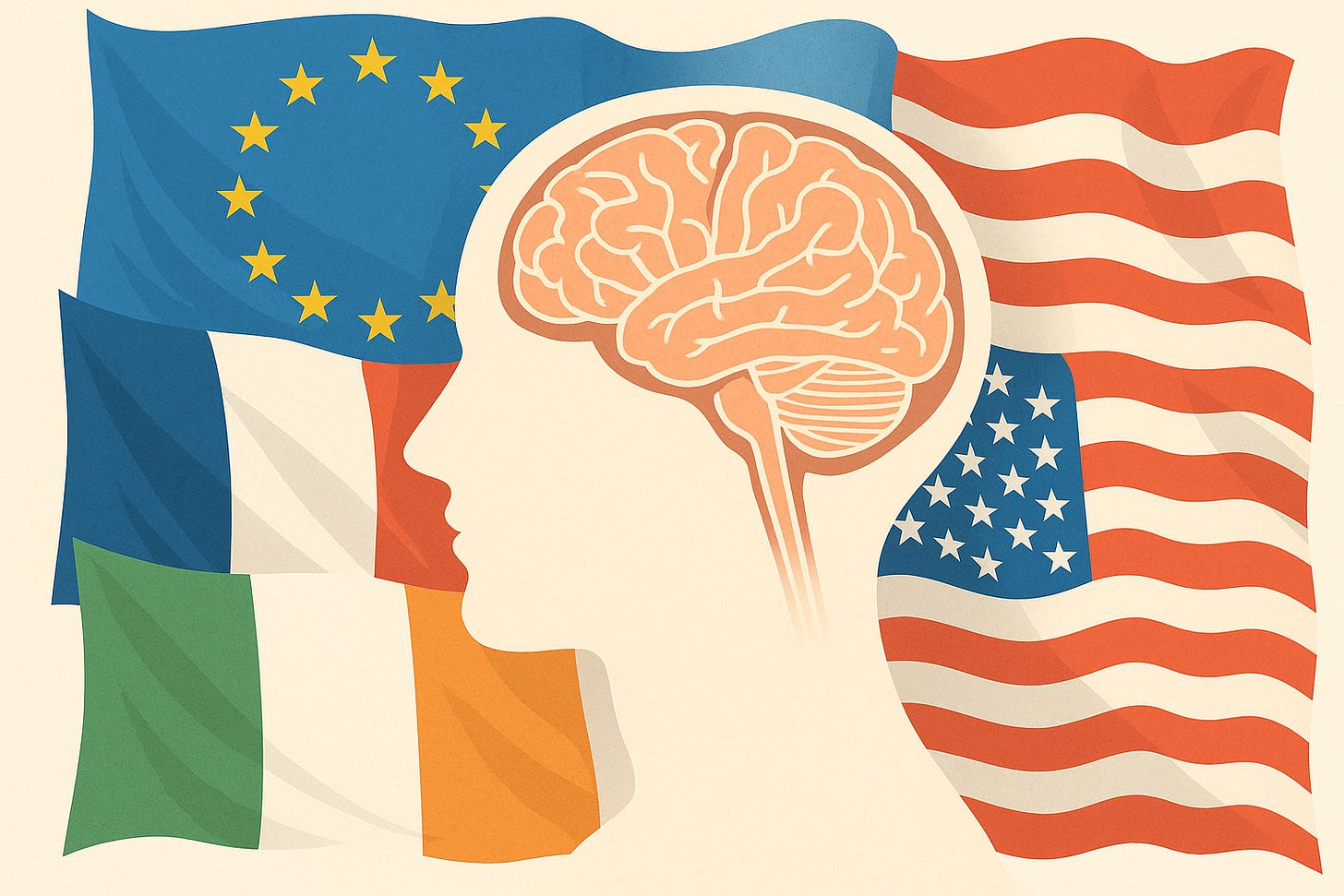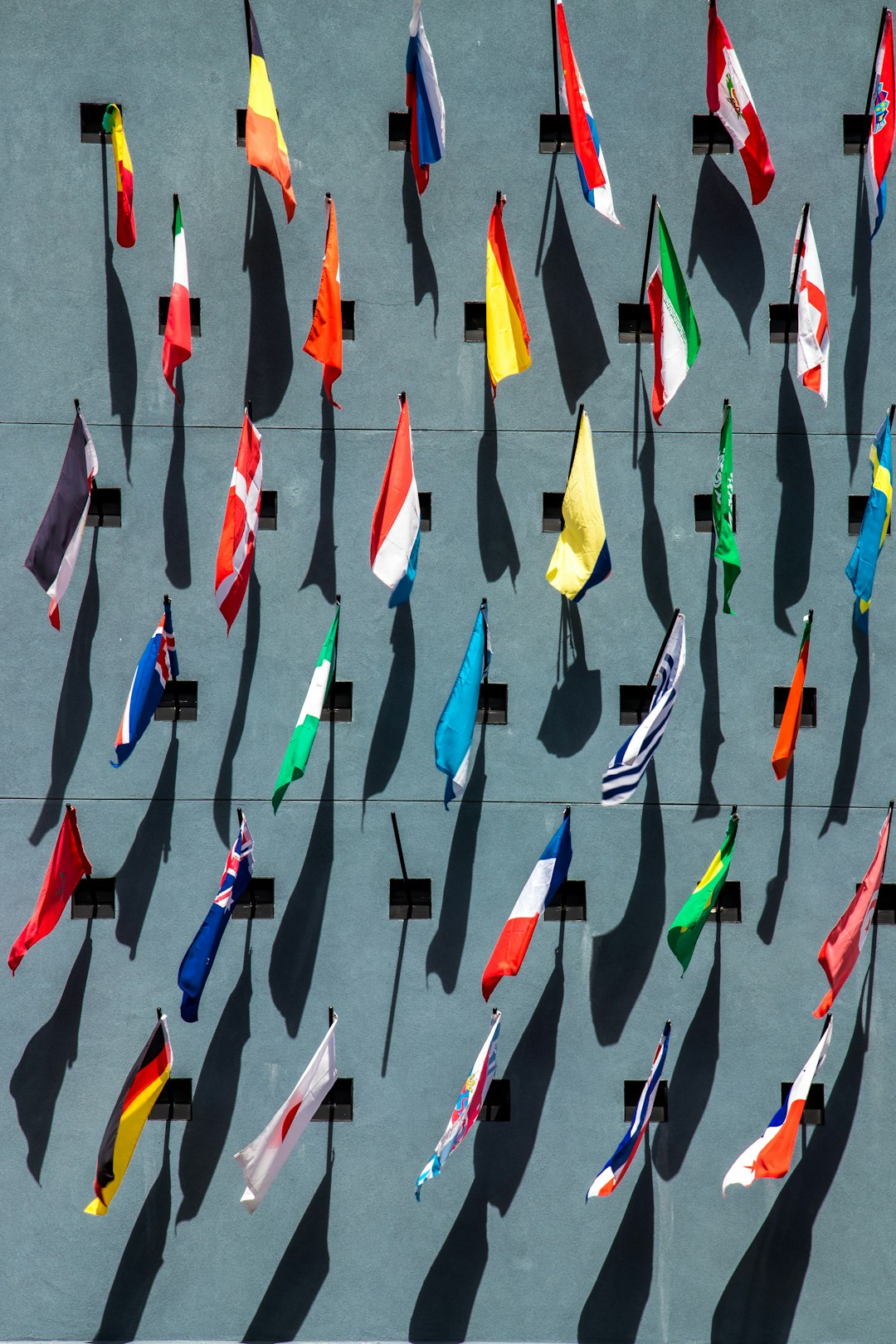From 'Neurons to Nations': How Nationalism Feels So Real
brains, borders, and national identity as a neurocognitive project (+podcast)
Nationalism (the deep psychological attachment to one’s nation) as an idea, a concept, can look like something abstract belonging to history or politics textbooks and something contained and constrained by international treaties.
In practice, however, nationalism lives in brains and bodies: in who moves you to tears during a World Cup final, who you silently stand beside at a war memorial, who you imagine when you hear the phrase ‘our people’, who you will fight and die and kill for, where your borders are, and the borders of other abut you, giving a lived reality to who is part of the in-group and those in the out-group.
Pink Floyd caught it brilliantly in their song ‘Us and Them’:
“Forward!” he cried from the rear/And the front rank died
The general sat, and the lines on the map/Moved from side to side
We usually analyse nationalism using lens from history, law, or political theory, and those lenses really do matter. But what lies underneath these lens? Humans are unique on the planet in having these thoughts and feelings - which means there must be a set of evolved capacities in the brain that make it possible for humans to feel attached to a vast group of strangers and to act in its name, sometimes at great personal cost.
This Substack piece draws on my recent research paper, ‘From Neurons to Nations: Neurocognitive foundations of nationalism’, and I’m trying here to translate the core ideas into a more accessible form.
I also did a podcast on the neuroscience of nationalism with
so you don’t have to read my new paper “From ‘Neurons to Nations’: Neurocognitive Foundations of Nationalism.”
And many of the ideas that are formally developed are first discussed in my book, ‘Talking Heads: The New Science of How Conversation Shapes Our Worlds’ (please buy it! And the audiobook version is read by me, and is a bargain atm: only £0.99 in the UK; only $0.99 in the US (Amazon.com).
nations as shared structures in the mind
Benedict Anderson’s famous phrase “imagined communities” is sometimes misunderstood to mean that nations are somehow unreal, because they are intangible cognitive concepts.
However, the fact that nations are imagined (that they are arbitrary if convenient cognitive constructions) tells us where to look: into the brain mechanisms [🧠] that allow millions of people who will never meet each other to experience themselves as part of a single “we.”
In the language of cognitive neuroscience, a nation can be described as a ‘shared neural representation’: a pattern of concepts, memories, emotions, and expectations that is broadly similar across many individual brains - there is no single “nation neuron”, or nationalistic brain region.
Instead, there are overlapping brain networks encoding:
A story about a collective past
A set of symbols, rituals, and landmarks
A sense of who belongs and who does not
Emotional reactions attached to that story and those boundaries
These shared representations are intangible, but they are most definitely real - even though they are intangible. They live in the same brain systems supporting autobiographical memory, social identity, and moral emotion. When those systems are exercised collectively, through schooling, media, and ritual, they scale up from “me” to “us”.
an evolved coalitional brain, and a recent political form
Nations did not exist on the African plains where we initially evolved and wandered about; there were no borders, except perhaps physical ones, and those in our imaginations. Humans did not evolve to produce the Westphalian nation-state, for that system of borders and passports is a very recent arrival in our species’ history. But we didn’t evolve to walk on the moon, discover the value of Pi, figure out that we can turn steam into electricity and a gazillion other things.
We have a cognitively very powerful, general purpose, brain with some unique properties that act as a force-multiplier.
What we did evolve is a coalitional, tribal mind where we share knowledge, thoughts, norms, ideas, learning with each other.
For tens of thousands of years, survival depended on identifying allies and rivals, remembering who did what to whom, tracking reputations, and coordinating with in-groups during conflict. We are exquisitely sensitive to group markers, to hints of loyalty and betrayal, to stories about shared ancestry and shared fate.
Nationalism is a cultural exaptation: a relatively new way of using very old psychological machinery. The same capacities that once bound small bands of hunter–gatherers now bind imagined communities of tens or hundreds of millions.
This helps explain a striking fact: a child adopted at birth from Indonesia to Ireland typically grows up with Irish national attachments, not Indonesian ones. The underlying brain systems are broadly similar in both cases, but the content they acquire is shaped by local history, language, and institutions.
The result is a form of identity that feels deeply natural, even though the specific narratives and symbols are historically contingent.
three key processes that build national identity in the brain
I argue nationalism leans on three intertwined sets of neurocognitive and affective processes:
1. memory and imagination
At the heart of human memory lies a system that links the hippocampal formation, anterior thalamus, and widespread cortical regions. This system supports episodic memory and what psychologists call mental time travel: the capacity to re-experience the past and imagine the future.
You use it when you remember your primary school classroom, or when you picture a holiday you have not yet taken. National identity taps into that same machinery, but now the content is collective:
The Easter Rising
The French Revolution
“We” as victims or heroes in war
The imagined future of the nation, as decline or renewal
Medial prefrontal cortex (mPFC) plays a key role in linking these memories and imagined episodes to the self. It helps answer questions such as “Is this about me?” and “Is this about my group?” When national narratives are repeatedly rehearsed, in education, media, and ritual, the brain gradually builds schemas that weave these stories into personal identity.
You do not simply know that there was a battle; you feel that it was our battle.
2. social categorization and group affiliation
The human brain categorises the elements of the world very quickly. We sort faces and names into “us” and “them” using minimal information, and this sorting has consequences for attention, memory, and emotion.
Neuroimaging and lesion studies suggest automatic reactions to out-groups often involve systems concerned with threat detection and learning from danger. Even very weak or arbitrary group labels can produce measurable in-group favoritism. When those labels are ethnic, religious, or national, centuries of history piggyback on these basic processes.
Over time, we acquire schemas for “our people” and for “others.” These schemas are not neutral filing systems, because they bias what we notice and what we forget, which stories feel plausible, and which moral judgments feel justified.
One striking set of findings comes from research on overclaiming. People routinely exaggerate their own country’s contribution to world events and underweight the contributions of others, even when objective records are clear. Memory is not simply distorted by patriotism; it is organised by it.
3. emotional bonding, ritual, and sacrifice
Nationalism is not just an idea. It is a felt phenomenon: emotions such as pride, empathy, anger, fear, and moral outrage are supported by widely distributed brain networks. These responses evolved for local social life: caring for kin, punishing defectors, defending territory. Nationalism recruits them for life in large-scale societies.
Pride in the national flag or anthem, supported by reward and valuation circuits
Empathy gaps toward out-groups, where suffering elsewhere does not register as strongly
Anger and moral outrage when sacred national symbols are attacked
Fear in response to perceived threats to “our way of life”
Rituals and symbols are powerful tools for synchronising these emotional responses. Singing in unison, marching, commemorating the dead, watching a key sports match, or standing for a minute’s silence, all provide repeated occasions where many brains are driven through similar emotional trajectories at the same time.
A further step is identity fusion. Here, the boundary between self and nation becomes so thin that harm to the group is experienced almost as personal harm. In fused individuals, willingness to fight, suffer, or even die for the group increases dramatically. This is not simple conformity; it is a deep alignment of individual and collective fate.
Cognitive Republic
Cognitive Republic (easy email sign up, so please do sign up) - I would be very grateful for your continued support.
learning the nation: childhood and adolescence
None of this is present at birth: children do not arrive into the world with a fully formed sense of nationality, of who their in-group is, where the out-group lives, and the like.
By early primary school, however, most children can correctly identify their country and flag, and they start to show biases that favour people from “their” nation over others. As their cognitive capacities expand, they become able to grasp large-scale categories such as “country,” “government,” and “citizen.”
Who “we” are
Who has wronged us
Who we have wronged
What counts as loyalty or betrayal
These narratives fuse with personal memory: a teenager does not just recall a date from a textbook; they remember watching a documentary, standing at a monument, or chatting with a grandparent. Over time, they learn not only to recall events but to feel which events matter and why.
collective memory: how institutions write inside our heads
French sociologist Maurice Halbwachs argued that memory is inherently social: we remember with others and through others. Cognitive neuroscience has now caught up with this intuition.
Collective memory is not simply a sum of individual recollections: it is shaped by communication, institutions, and power. States invest heavily in museums, archives, textbooks, national holidays, and public ceremonies. These are not neutral investments, because they emphasise certain historical episodes and interpret them in particular ways. And they can be silent on other events, because they do not fit the current prevailing narratives.
From a neurocognitive perspective, these practices amount to large-scale exercises in guided encoding and retrieval from memory.
They influence:
Which historical episodes are rehearsed often enough to become stable in memory
Which emotional tags are attached (triumph, shame, grievance, grief)
How tightly those historical episodes are linked to national identity
In this sense, nationalism is not just about borders and constitutions: it is about who controls the stories that repeatedly activate specific memory, valuation, and social cognition circuits across a population.
why this matters for conflict, cohesion, and ethics
Understanding nationalism as a neurocognitive construct does not mean treating citizens as lab rats for social engineers. It does, however, change how we think about what is possible.
If national identities are sustained by plastic brain systems, then they are:
Powerful, because they harness deep evolutionary machinery
Flexible, because neural circuits can learn and unlearn
Contestable, because different actors can try to shape the stories and symbols that keep those circuits active
This has some clear ethical implications:
Is it legitimate to intentionally design national narratives and rituals in order to reduce intergroup hatred and foster inclusive forms of patriotism?
Who decides what counts as a “healthy” identity?
How do we distinguish democratically negotiated memory from manipulation?
How do we protect cognitive freedom and individual agency while acknowledging that no-one’s mind is formed in isolation?
Any programme aiming to cultivate more peaceful or inclusive national identities must be transparent, pluralistic, and open to contestation. People should be taught how their own sense of identity works, so that they can recognise attempts to weaponise their emotions and memories, and choose their attachments with greater awareness.
where research goes next
The emerging cognitive neuroscience of nationalism is still young. A few promising directions include:
Linking individual brains to collective behaviour: How do specific neural patterns of identity fusion or out-group dehumanisation predict real-world political choices, from voting to protest to participation in violence?
Tracking change over time: What happens in the brain when someone shifts from narrow ethnonationalism to more inclusive forms of identity, or in the other direction?
Studying interventions: Can certain types of contact, education, or media narratives reshape group schemas and emotional responses in durable ways, without simply pushing prejudice somewhere else?
Comparing national contexts: The Irish, Indonesian, or Indian national stories are very different historically, yet they rely on broadly similar cognitive ingredients. Cross-cultural work can reveal which aspects of nationalism reflect shared human capacities and which are local specialities.
At stake here is more than a tidy theoretical neurocognitive account, for we live in a period of resurgent ethnonationalism, intense polarization, and deepening global interdependence. Understanding how brains build nations, and how nations live inside brains, is one route to thinking more clearly about both the promise and the peril of this familiar, unsettling, remarkably resilient force in human affairs.
This essay is based on my research paper “From ‘Neurons to Nations’: Neurocognitive foundations of nationalism,” published in Neuroscience & Biobehavioral Reviews (2025) (there’s lot of technical detail in there).




